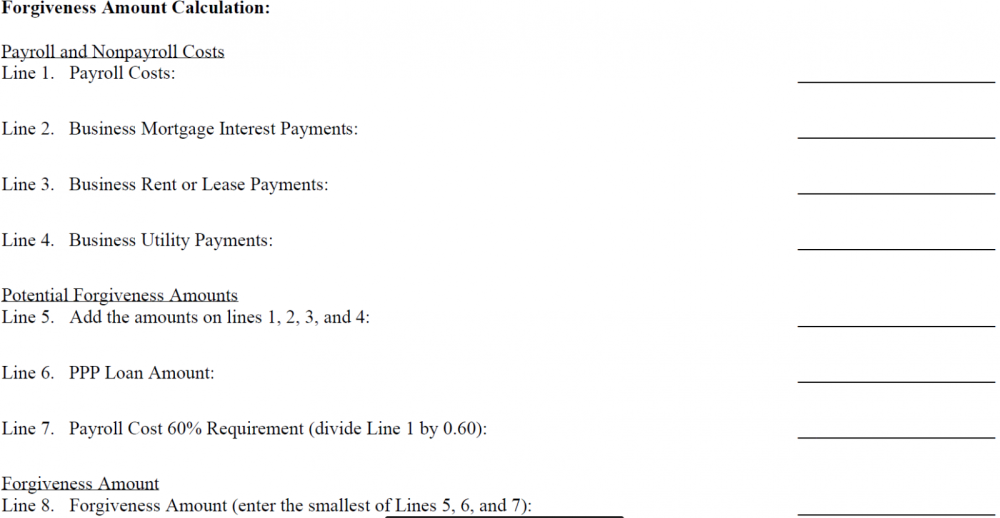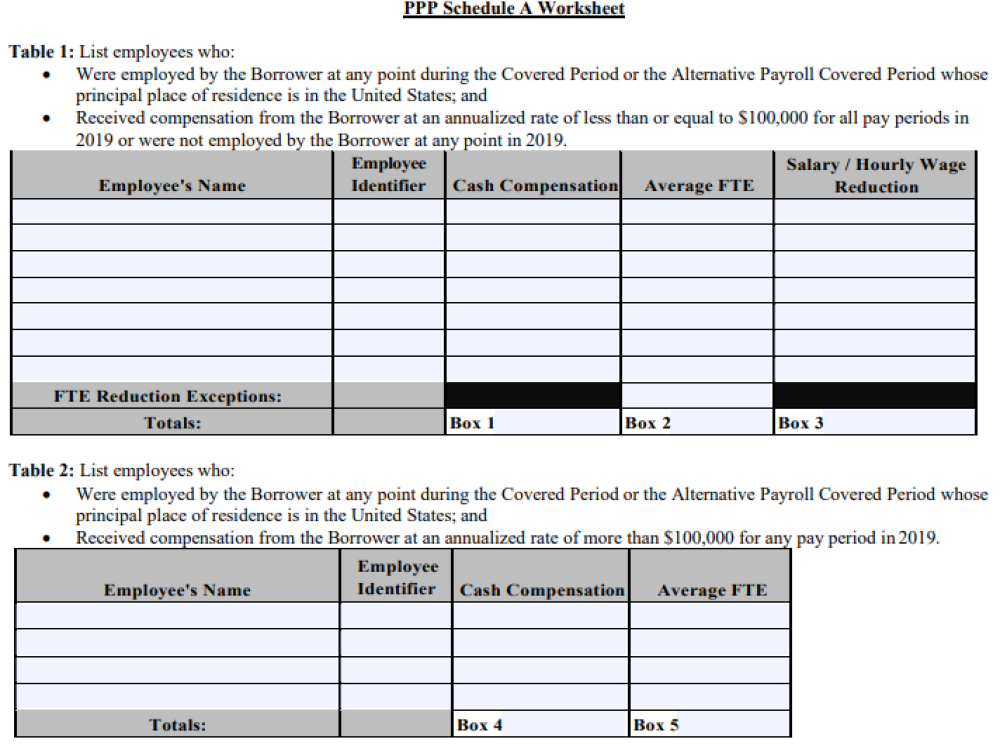

On June 16, 2020, the Small Business Administration (“SBA”) issued a revision to the very first April 2, 2020 Interim Final Rule, indicating that they would be reissuing the May 22, 2020 Interim Final Rules on Loan Forgiveness and SBA Loan Review to address amendments the Flexibility Act made to the loan forgiveness requirement. The very next day, SBA issued two new PPP Loan Forgiveness applications. We have yet to see revisions to the May 22, 2020 rules to help us interpret any uncertainty created by the new application forms.
But now for some good news! If you are confident you did not reduce their hourly wages and have been able to restore their hours (or have a qualifying exemption) you will be excited to know that the new 3508 EZ form will soon be available for use in applying for loan forgiveness. We are currently working with our online application service provider to incorporate the new, shorter 3508 EZ form, including logic to determine eligibility, for release in early July. In the meantime, we encourage you to continue to do your research to determine what is best for the individual circumstances of your business. The US Chamber of Commerce has issued a guide to help you think through individual forgiveness scenarios here. We’re also highlighting several of the most common questions from clients in today’s blog post.
Why does line 8 of the PPP Loan Forgiveness Application Form 3508EZ have me divide expenses by .60?
Under the PPP Flexibility Act signed into law on June 5, 2020, a borrower can now be eligible for full loan forgiveness if 60% or more of their loan forgiveness amount went towards payroll costs rather than the 75% originally mandated by the CARES Act. Loan forgiveness is based upon the smaller of your original loan amount, your eligible expenses, or your payroll costs plus up to 40% eligible nonpayroll expenses (which, algebraically, is payroll costs divided by 60% or .60).
So, let’s say you received a loan for $100,000. You spent $100,000 over the covered period.
 You spent 60% or more on payroll expense so you could have received forgiveness for up to $125,000 if you divided those expenses by .60 per line 7 of the application form.
You spent 60% or more on payroll expense so you could have received forgiveness for up to $125,000 if you divided those expenses by .60 per line 7 of the application form.BUT, you cannot receive forgiveness for more than the original loan amount OR more than your actual expenses, so you would still only receive forgiveness for $100,000.
If that same borrower only spent $50,000 on payroll costs, they are only eligible for a maximum of $83,333 in total loan forgiveness. The remaining balance of the $100,000 loan would be have to be paid back at a rate of 1%, following a 10-month deferment of interest and principal.
Basically, the change allows someone who only spent $60,000 of the original $100,000 loan amount on payroll expense to be eligible for full loan forgiveness. Loan forgiveness can also be reduced if you did not maintain or restore your FTE (and don’t have an eligible exemption) or if you reduced the salaries or wages of individual employees.
You cannot use the new EZ form if you reduced the salaries or wages of your employees by more than 25%.

We continue to await revisions to the May 22 Interim Final Rule before we can launch the new version of the form, however, the SBA press release issued on June 17, 2020, indicates that the form can only be used when you:
The new EZ form includes a Borrower Certification, “The Borrower did not reduce salaries or hourly wages by more than 25 percent for any employee during the Covered Period or Alternative Payroll Covered Period compared to the period between January 1, 2020 and March 31, 2020. For purposes of this certification, the term “employee” includes only those employees that did not receive, during any single period during 2019, wages or salary at an annualized rate of pay in an amount more than $100,000.”
If you reduced average wages during the “covered period” or “alternative covered period” by more than 25 percent compared to the average of what that employee was receiving in Q1 2020, you may still be eligible for partial loan forgiveness but you will be required to use the Full Loan Forgiveness Application, which includes the Schedule A Worksheet depicted here. You would list any employee paid during your elected “covered period” or “alternative covered period” who received compensation that, when annualized, is less than or equal to $100,000 and who was on your payroll during Q1 2020.
Long story short, if you did not reduce the annual salary or hourly wage during the covered period you elected for using your PPP loan proceeds, and you had no reduction in hours or any reduction in hours was because of lost business activity due to health directives related to COVID-19, you can save yourself some aggravation by electing to use the new 3508 EZ Form.

Borrowers can choose between the following reference periods in determining whether FTE has been reduced:
Borrowers will not be penalized for any FTE reductions if either of the following occurred:
Sort of. Previously an employee earning a salary of $100,000 was considered at a cap for loan forgiveness of $15,384, dividing $100,000 by 52 weeks and then multiplying that out for the 8-week period. If, however, you elect the 24-week covered period you are now capped under the Interim Final Rule issued on June 19, 2020 at $46,154 per individual taking into account the 24 weeks. Remember though that you were only eligible for a maximum PPP loan amount under the SBA PPP Loan Application Form 2483 that was 2.5X your average monthly payroll costs. So, this new per-individual maximum would only be reached if you reduced your FTEs.
Your total loan forgiveness amount will never be more than the full principal amount of the original loan, plus accrued interest. In addition, if FTE count was reduced you must be eligible for an exemption (safe harbor) or you will reduce the total amount of your loan forgiveness.
For self-employed borrowers, the Interim Final Rule issued on June 19, 2020 indicates that loan forgiveness continues to be capped as he rule notes,
“individuals with self-employment income who file a Schedule C or F are capped by the amount of their owner compensation replacement, calculated based on 2019 net profit (8/52 of 2019 profit) of $15,385 for an 8-week covered period or 2.5 months’ worth (2.5/12) of 2019 net profit (up to $20,833) for a 24-week covered period per owner in total across all businesses”.
SBA clarifies that for borrowers with no employees, this limitation will have no effect, because the maximum loan amount for such borrowers already includes only 2.5 months’ worth of their 2019 net profit. If a self-employed borrower has employees, the cap remains $20,833 for themselves over 24 weeks so as not to create a “windfall for the owner”. The rule provides the example of a self-employed borrower with one other employee noting that without the cap the owner might otherwise receive five months of payroll instead of 2.5 months, defeating the purpose of the CARES Act of protecting the paycheck of the employee.
SBA is expected to issue new Frequently Asked Questions (“FAQs”) and interim final rules to implement the provisions of the PPP Flexibility Act in the coming weeks. In the meantime, we invite you to visit the FAQs on our website for additional information on required documentation. Stay tuned for your personal invitation to apply for loan forgiveness, which will be delivered via email after July 1, 2020 for those borrowers who were approved prior to June 5, 2020. Stay well!
Previous: Pros and Cons of Homeownership Next: SBA Issues Revisions to PPP Forgiveness